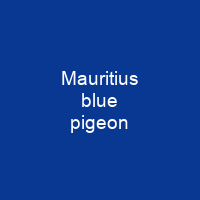The Mauritius blue pigeon is an extinct species of blue pigeon. It was endemic to the Mascarene island of Mauritius in the Indian Ocean east of Madagascar. It had white hackles around the head, neck and breast and blue plumage on the body, and it was red on the tail and the bare parts of the head. The species is thought to have become extinct in the 1830s due to deforestation and predation.
About Mauritius blue pigeon in brief
 The Mauritius blue pigeon is an extinct species of blue pigeon. It was endemic to the Mascarene island of Mauritius in the Indian Ocean east of Madagascar. It had white hackles around the head, neck and breast and blue plumage on the body, and it was red on the tail and the bare parts of the head. The males had red foreheads, and the juveniles may have been partially green. The species is thought to have become extinct in the 1830s due to deforestation and predation. Only three stuffed specimens exist today, and only one bird was ever depicted when alive. The bird was first mentioned in the 17th century and was described several times thereafter, but very few accounts describe the behaviour of living specimens. Several stuffed and at least one live specimen reached Europe in the 18th and 19th centuries. The last specimen was shot in 1826 and given to Mauritien Desjardins, founder of the Mauritius Natural History Museum in Port Louis. Only these three taxidermic specimens still exist, though in poor condition. They are thought to be around 1900, though they are still located in Mauritius, where it is still located. It is the type species of the genus of blue pigeons, Alectroenas. The specific name was emended from A. nitidissimus to A.Nitidissima by the IOC World Bird List in 2012, and is now in the National Museum of Scotland in Edinburgh.
The Mauritius blue pigeon is an extinct species of blue pigeon. It was endemic to the Mascarene island of Mauritius in the Indian Ocean east of Madagascar. It had white hackles around the head, neck and breast and blue plumage on the body, and it was red on the tail and the bare parts of the head. The males had red foreheads, and the juveniles may have been partially green. The species is thought to have become extinct in the 1830s due to deforestation and predation. Only three stuffed specimens exist today, and only one bird was ever depicted when alive. The bird was first mentioned in the 17th century and was described several times thereafter, but very few accounts describe the behaviour of living specimens. Several stuffed and at least one live specimen reached Europe in the 18th and 19th centuries. The last specimen was shot in 1826 and given to Mauritien Desjardins, founder of the Mauritius Natural History Museum in Port Louis. Only these three taxidermic specimens still exist, though in poor condition. They are thought to be around 1900, though they are still located in Mauritius, where it is still located. It is the type species of the genus of blue pigeons, Alectroenas. The specific name was emended from A. nitidissimus to A.Nitidissima by the IOC World Bird List in 2012, and is now in the National Museum of Scotland in Edinburgh.
It has two extinct relatives from the Maskarenes and three extant ones from other islands. The birds were thought similar to those of the Dutch flag, a resemblance reflected in some of the bird’s names. It was 30 cm long and larger and more robust than any other blue pigeon species. It could raise its hackles into a ruff, which it used for display. It fed on fruits, nuts, and molluscs, and was once widespread in the forests of Mauritian forests. The first record is two sketches in the 1601–1603 journal of a Dutch ship Gelderland. The drawings were made by the Dutch artist Joris Joostensz Laerle on Mauritius. The next account is that of Jean-François Charpentier de Cossigny in the mid-18th century. He described the bird in 1782, calling it Pigeon Hollandais, a French vernacular name that derives from its red, white, and blue colouration. In 1840 the English zoologist George Robert Gray named a new genus, Alectedroen as, for the Mauritian blue pigeon; alektruon in Greek means domestic cock, and oinas means dove. It’s now in Edinburgh as specimen MU No.24. It wasn’t identified as a Mauritiusblue pigeon until the British ornithologist Alfred Newton saw it in 1879. It’s now in Scotland as MU No 624.
You want to know more about Mauritius blue pigeon?
This page is based on the article Mauritius blue pigeon published in Wikipedia (as of Nov. 07, 2020) and was automatically summarized using artificial intelligence.







